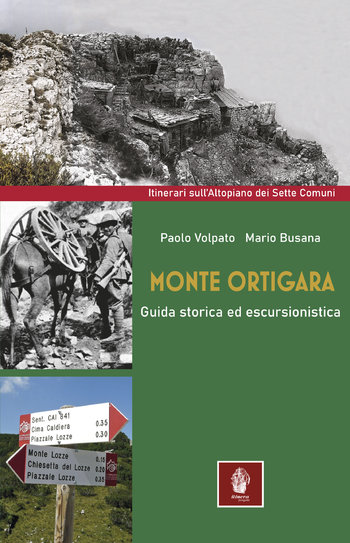
In collaboration with Asiago.it
-
Title Mount Ortigara
-
Subtitle Historical and hiking guide
-
Pages 176
-
Photos 100
-
Cover price € 9,90
-
Publisher Itinera Projects
-
Author Paolo Volpato, Mario Busana
-
Publication Date N/A
-
Reference 978-88-32239-21-8
- Buy direct online
Buy Now
New book "Monte Ortigara — Guida storica ed escursionistica" by Paolo Volpato and Mario Busana published by Itinera Progetti in collaboration with Asiago.it.
you can immediately buy the book in bookstores, online and (only until July 22, 2021) also as an attachment to the Giornale di Vicenza.
❧❧❧❧
DESCRIPTION
In the Italian historical panorama of the First World War there is a name that perhaps more than any other embodies the horror, the tragedy, the inadequate preparation to face the first war conflict of the modern era; this name is Ortigara. Not for nothing, the rhythm of the ta-pum of the snipers, punctuated by one of the most famous war songs that accords to this name, has entered the national collective imagination, creating a symbolic equation that has now deeply rooted in the bowels of this mountain: Ortigara equal death.
Even today, those who climb the arid peaks that mark the border between the Venetian plateau and the Trentino valleys, do so with reverence, with respect, almost with fear. And if speaking of Ortigara, the risk is to fall into the repetition of the facts, in the obviousness of the analyzes, just remember once again what the witnesses told, like that Alpine who left said: "The ugliest war I saw on the Ortigara".
Much has been written about this battle that now has few secrets to hide. However, a careful reflection of the events that have occurred, we can still see a message to be collected and handed down to future generations. On what is probably the most evocative monument of the Great War, the severed column placed at an altitude of 2,105 of the Ortigara, there are engraved three bare words: "NOT TO FORGET". Well, the message that those who engraved them wanted to leave us has a double value. Do not forget, you future generations, the suffering, the pain, the torment that brings with it war, even the most just, even the one that seems and sometimes is necessary. But above all, do not forget those who have experienced these feelings directly, do not forget the men who have experienced this tragedy on their own skin, sometimes unaware sometimes voluntarily going to meet it. Do not forget the man, the boy, the father, the son, the groom who here have always had to struggle with the thought of the distant family.
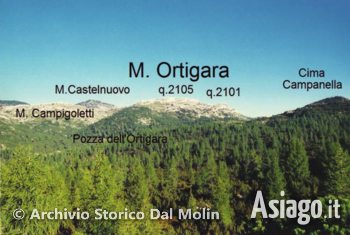
The attempt we are going to make is precisely to live from within the emotions and sensations that animated the protagonists. The attempt is to give a name and a face to the thousands of Alpini who fought, because if it is easy, in the re-enactments, to expose terrible but still arid figures, it is equally difficult to make it clear that behind each number there is a person who brought with him in battle his own baggage of experiences, who had a unique and unrepeatable life story, who had left other human beings waiting for him, who at some point had to come out into the open, he felt targeted like a cardboard silhouette, he had to fight and kill so as not to be killed.
To them and to subsequent generations, who continued its traditions in other tragic theaters of war, this book is dedicated.
The toponym Ortigara indicates a mountain that in reality constituted only one, and not even the most important, of the objectives that the Italian attack launched in the first part of the summer of 1917 set itself. The front that sees the troops of the 52nd Alpine Division as protagonists is not wide, it is only about a kilometer and a half of line, and includes, starting from the north, altitude 2,003 (for the Austrians 2,007), the Passo dell'Agnella, the Ortigara with the two altitudes 2,101 (for the Austrians altitude 2,075 "Le Pozze") and altitude 2,105 (for the Austrians altitude 2,107), Ponari Region, Valle dell'Agnella and Monte Campigoletti. The latter, adjacent to the Ortigara, must be included by right as its failure to conquer will be decisive in the unfolding of events.
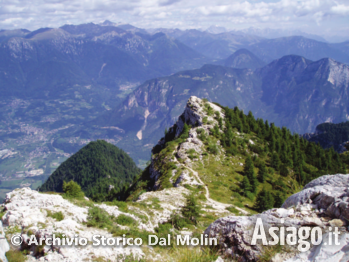
The prodromes of the battle are to be found in the previous year, when following the Austrian offensive in South Tyrol, which entered history with the name of Strafexpedition, the Italian defensive line had to retreat to the edge of the plateau of the Seven Municipalities, thus abandoning positions that were considered of capital importance for the protection of the borders. While managing to contain the descent to the plane of the imperial troops, the Italian army was forced by the skillful enemy maneuver of retreat to take a new line absolutely inadequate and in a tactical position subordinate to that of the Austro-Hungarian army. And that's not all. Strategically Trentino, and now also part of the occupied Veneto, continued to exercise the function of a dangerous wedge strung between the troops in line on the Isonzo front, the main direction of attack, and the rear of the country, especially those where the war industry guaranteed the continuous supply of material necessary for the continuation of the war.
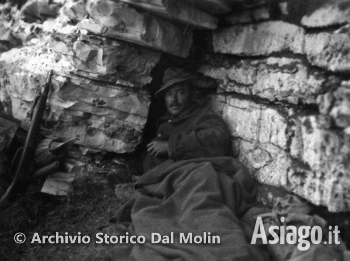
It was therefore necessary, according to the intentions of Cadorna, the reconquest of the positions lost in 1916, first of all Cima Portule, true corner head of the pre-Alpine front, sentinel of the entire plateau and junction with the adjacent Dolomite front. In reality, the attempt is not new. Already at the end of the Strafexpedition, Cadorna thought of using the troops of the newly formed 5th Army to press the enemy in retreat and regain the lost ground. But with one of those operations that, despite their difficult appreciability, are by right among the most important of the entire conflict, the Austro-Hungarian troops silently disengaged from the Italian ones and managed to gain the new defensive line prepared in a very short time, strong in the knowledge of a terrain that did not give any foothold to the offensive maneuver. And if at first the Ortigara did not fall within the new Austrian line, which had as its extreme stronghold Cima Dieci, Monte Calstelnuovo for the Italians, later it was probably included for its high defensive potential and was therefore included in the geographical sequence: Val d'Assa, M. Interrotto, M. Zebio, M. Chiesa, Porta Lepozze, or the Ortigara . On the other hand, the same Italian command did not consider it worthy of mention, if in the first orders of operation, all aimed at the most important destinations of Cima Castelnuovo, Cima Dodici and Cima Portule, the name of the mountain is not included among the objectives to be achieved.
The battle on Monte Ortigara was fought between 10 and 25 June 1917, but despite the short interval of time it remains, and will remain, imprinted in the collective memory of those who lived it as "the calvary of the Alpini".
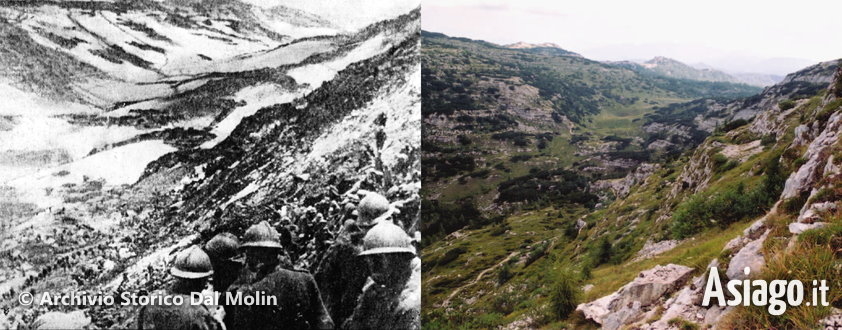
❧❧❧❧
INDEX
Introduction
Prodromes of the battle
MILITARY OPERATIONS OF 1916
The Strafexpedition
The Alpini enter the field
The Bassano Battalion
The Seven Municipalities Battalion
Departure for the Plateau
The Battle of the Castelloni di San Marco (16/18 June 1916)
The actions of 16 June
The actions of 17 June
The events of June 18 and the following days
The reconquest of Cima della Caldiera (June 26, 1916)
The first cycle of operations against M. Ortigara (30 June/10 July)
Operations from 21 to 24 July
Operation K
MILITARY OPERATIONS OF 1917
The "Defensive in hypothesis one"
The second cycle of operations against Monte Ortigara (10/15 June)
From 19 to 23 June
The loss of Ortigara (24/25 June)
The end of the battle
The Battalions Seven Municipalities and Bassano
Final Thoughts
The Alpine Battalions in the Battle of Ortigara
BATTLEFIELD ITINERARIES
Curated by Mario Busana
Itinerary 1 - Path with Tricolor trail marker
Itinerary 2 - Cima Caldiera, Cima Ortigara, Valle dell'Agnella
Itinerary 3 - Walkways and trenches
Itinerary 4 - Austrian Cemetery III/37°
Notes
Bibliography
Thanks
All rights reserved.